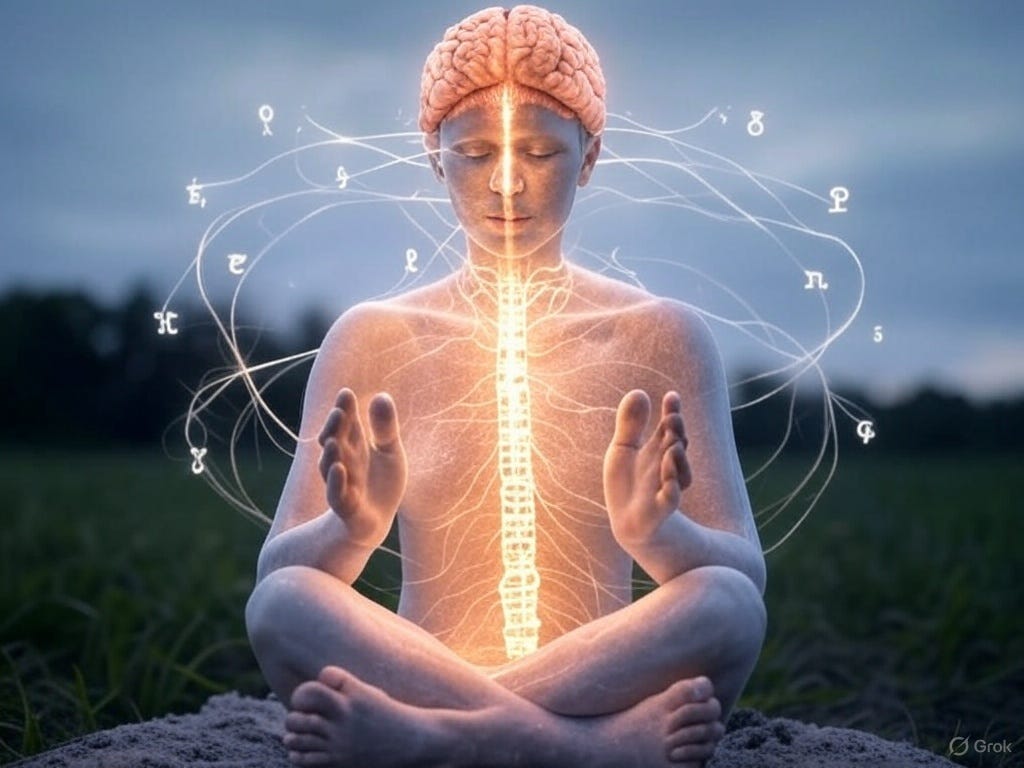There have been many conversations circling around the Feldenkrais ‘body’ (of practitioners from all parts of the world) about the neurological benefits of movements involving the connection of hands with feet…. which is some of what today’s lesson invites us to do.
So when I asked Grok to find out why this loop is so powerful,
it responded with:
“When you move your hands toward your feet in these slow,
deliberate ways
—crossing limbs, sliding arms, and involving the head and shoulders—
you’re engaging multiple parts of your nervous system at once.
The brain thrives on this kind of coordinated, mindful movement.
Here’s what happens:
Improved Neural Mapping:
The brain maintains a "body map" in the sensory and motor cortices,
which helps you sense where your limbs are and how they move.
By connecting your hands to your feet in unusual ways
(like crossing legs and reaching across the body),
you challenge and refine this map.
The slow pace allows your brain to notice subtle differences,
enhancing its ability to organize movement more efficiently.Cross-Body Integration:
Crossing the right leg over the left while moving the right hand toward the left foot
(or vice versa) activates communication between the brain’s two hemispheres
via the corpus callosum.
This builds stronger connections across the midline,
improving overall coordination and balance.
It’s like a gentle workout for the brain’s ability to integrate left and right,
up and down.Attention and Awareness:
The Feldenkrais Method emphasizes moving with attention, not force.
As you slide your arm toward your foot and include your head
“whichever way it wants to turn,”
you’re training your brain to listen to your body’s natural preferences.
This heightens proprioception (your sense of body position)
and quiets mental chatter, fostering a calm, focused state.Plasticity in Action:
Each time you repeat a movement “many times, slowly,”
and notice it becoming easier, your brain is adapting.
This is neuroplasticity at work—new neural pathways form as you explore unfamiliar patterns, making complex actions feel simpler over time.
The brain learns to distribute effort across the whole body,
rather than over-relying on a few parts.Spinal Connection:
Involving the head, shoulders, and pelvis as you reach for your feet
wakes up the spine’s role in movement.
The brain starts to see the body as a unified system,
not just a collection of parts.
Lifting and lowering the legs while holding the toes,
presses different spinal segments into the floor,
giving the brain feedback about how the back supports everything else.”
I also asked it about the ontological, or existential benefits we might experience:
“Beyond the brain’s wiring,
this lesson invites a shift in how you inhabit yourself
—aligned with Feldenkrais’s focus on self-awareness and possibility.
Here’s what it offers on a deeper level:
A Sense of Wholeness:
Reaching across your body to connect hands and feet
reveals how interconnected you are.
Shoulders soften, ribs twist, pelvis tilts
—all parts join the movement.
This mirrors life: when you act with your whole self,
rather than in fragments,
you feel more present and capable.
It’s a quiet reminderthat you’re not just a mind or a pair of hands,
you’re a unified being.Freedom Through Ease:
The instruction to move “slowly, gently” and “without extra effort”
teaches you to let go of struggle.
As you rest after each step and sense the floor differently,
you might notice tension melting away.
This isn’t just physical—it’s a way of being.
You learn that progress doesn’t require force,
opening up new possibilities for how you approach challenges.Embodied Curiosity:
Each step asks,
“How much of you is involved?”
or, “What do you sense differently?”
This curiosity about your own experience
fosters a richer relationship with yourself.
You start to see your body not as a machine to command,
rather as a living system to explore
—a shift that can ripple into how you engage with the world.Adaptability and Resilience:
Working toward holding your foot or toe,even if it’s hard at first,
reflects the Feldenkrais idea that small,
intentional steps lead to big changes.
This builds confidence in your ability to adapt.
By the end, standing and feeling
“how this lesson has affected all of the systems you live within,”
you might sense a new lightness or length
—a tangible shift in how you carry yourself through life.Grounded Presence:
Repeatedly returning to rest and noticing the body’s contact with the floor
anchors you in the present moment.
This grounding can shift your perspective,
making you feel more at home in your skin.
It’s less about ‘doing’ and more about ‘being’
—a subtle but profound way to exist.”
When you stand at the end,
you might find the world feels a little different
—not because it’s changed,
rather,
because you have.
Keep reading with a 7-day free trial
Subscribe to MySelf.Study to keep reading this post and get 7 days of free access to the full post archives.


